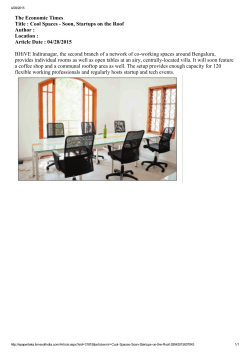
PDF: FoP-document about the value of Public Space
I N T E R N AT I O N A L CONFERENCE Benefits of Public Space Public space is a vital component of a prosperous city. Well designed and managed public spaces are a key asset for a city’s functioning and has a positive impact on its economy, health, climate, safety, integration and connectivity. The quality of life for people in cities is directly related to the state of its public spaces. Public space is one of the key pillars of urban and global sustainable development, accompanied by appropriate enabling legislation and a dequate financial and economic measures that promote public revenue, private income and investment and wealth creation. Public space supports the economy Well designed and managed public spaces add economic value to places and can therefore positively affect the local economy, employment opportunities, business investments, tourism, etc. A high-quality public environment can have a significant impact on the economic life of urban centres big or small, and is therefore an essential part of any successful regeneration strategy. As cities increasingly compete with one another to attract investment, the presence of good streets, market places, parks, squares, gardens and other public facilities becomes a vital business and marketing tool. In addition, good public spaces can increase the land values of the adjacent properties. Entrepreneurs, large or small, are attracted to locations that offer well-designed, well-managed public places and these in turn attract customers, employees and services. Public space fosters social cohesion Public space provides room for social and cultural interaction and can foster a sense of belonging and pride in an area. A public space that is open to all, regardless of ethnic origin, age or gender, provides a democratic forum for citizens and society. When properly designed and cared for, they bring communities together, provide meeting places and foster social ties of a kind that have been disappearing in many urban areas. These spaces shape the cultural identity of an area, are part of its unique character and provide a sense of place for local communities. Public space is often referred to as ’the poor man’s living room’ which hints at its particular importance for the recreation of vulnerable groups, http://futureofplaces.com but also its ability to foster integration between different socio-economic groups. Improving access to good public spaces for the most vulnerable urban residents is a powerful tool to improve equity, promote inclusion and combat discrimination. Cities that strive towards social equity need to provide access to good public spaces (streets, market places, recreation facilities, etc.) so as to enhance community cohesion, gender equality and civic identity. Women use the streets and public spaces more frequently and for a greater variety of purposes than men. Women are more likely to use the city’s network of public spaces. Approaches may vary from street lightening to initiatives promoting urban safety. info@futureofplaces.com @futureofplaces I N T E R N AT I O N A L CONFERENCE Public space enhances safety A mixed and diverse public space (use, users, design, state, time, etc.) provides a place that is vibrant and busy automatically reducing insecurity. Fear of crime and, to a much lesser extent crime itself, can deter people, not just vulnerable groups, from using even good-quality public spaces. Children, youth and elderly, for example, are often prevented from using our parks, squares and streets because of fear of crime and violence. In addition, women often face particular concerns, and due to fear of crime and violence are often restricted from entering public space in some areas. Physical changes to, and the better management of, public space can help to allay these fears. Particularly, public space can reduce perceptions of insecurity through attracting a large cross section of people at all times of day. Public space improves public health Quality public spaces improve our health by providing opportunities for physical activity and play, making walking more attractive, reducing stress and providing a calming environment. Access to good-quality, well-maintained network of public spaces can help to improve our physical and mental health by encouraging us to walk more, to play, or simply enjoy the environment. In other words, our open spaces are powerful weapons in the fight against many forms of ill-health. For example, play is crucial for many aspects of children’s development; from the acquisition of social skills, experimentation and the confrontation and resolution of emotional crises, to moral understanding, cognitive skills such as language and comprehension, and of course physical skills. In addition, green public space provides an opportunity for people to be close to ‘nature’, with the associated positive impact that this can bring in terms of mental health and the simple pleasure of experiencing wildlife in an urban situation. Public space increases transportation efficiency Public space can reduce congestion, travel time and road accidents through appropriately designing and managing different transport modes and prioritizing routes for walking and cycling. One of the fundamental functions of public space is that it allows us to move around and to access– on foot, by bicycle, by car, motorbike or public transport. A key objective of urban design and management is therefore to reconcile the needs of these often conflicting modes of transport. Well-designed streets and public spaces encourage walking and cycling, and have the power to create a safe environment by reducing vehicle speeds and use. Concepts such as shared space or home zones are demonstrating the benefits of redesigning streets for shared use for all modes of transportation. Public space improves the environment Green and open public space brings many important environmental benefits to urban areas, including the cooling of air and the absorption of atmospheric pollutants. The significant increase in hard surfacing and the reduction in green spaces lead to higher temperatures in towns and cities than in the surrounding countryside. Vegetation in the public space can help to redress this imbalance. Public space can also help mitigate climate change by linking places together, making it easier and more attractive to move around by walking and cycling, improving the environment around public transport hubs, encouraging people to use public transport, minimising carbon emissions through the choice of materials and construction technologies. Public space can also help adapt to the effects of climate change by acting as sustainable drainage system, solar temperature moderator, source of cooling corridors, wind shelter and wildlife habitat.
© Copyright 2025










